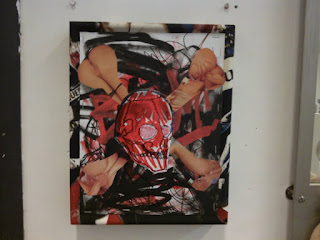| "...dancers perform while a scientist reads in Cern's library." Photograph: Maximillien Brice/cern. | via: The Guardian |
The audio I recorded will find its way into an upcoming Dead Hare Radio podcast, along with more links and information.
My interview with Ariane Koek took place on Wednesday. Early in the day on Thursday, I returned to the Musee d'art e d'histoire, and this time, the painting galleries were open. It was a quick visit although was struck by some familiar but forgotten faces on the walls of those galleries. Specific works of Félix Edouard Vallotton, Giovanni Giacometti, Ferdinand Hodler and others, as it turns out, had lodged themselves into deep recesses in my brain, this became only evident when standing directly in front of these works.
On this visit my attention was commandeered by the pastels of Jean-Ètienne Liotard. Really exquisite and glowing pastel portraits that seem more radiant and compelling because of the medium in which they're created. In this group of drawings, the rosy illuminated flesh tones luxuriate in relation to the clear powdery blue in many of the sitters' garments. I'll work on getting some images to plug into this post. The image above is a brochure that accompanied an exhibit of Liotard drawings which I visited multiple times when it was mounted at the museum in 1992.
| Andre Dussoix, acrylic on canvas, via: karaartservers.ch |
On Thursday, I arranged my second (re)meeting of the trip with artist Andre Dussoix. Andre was among the group of artists, musicians and writers I encountered first in 1992. I have a publication given to me by Andre at that time which accompanied a multi media group exhibit which took place in 1984 and included the work of several members of this circle .
 |
| Espace Corps, large format publication. |
Even though I've never been able, nor have I really tried to read the publication in French which has long served in my mind as a talisman emblematic of the ideal of the creative collective. What I garnered from this group of artists-friends, who are collectively my elders by about 20 yrs, is the representation of the possibility of maintaining productive creative relationships through the long haul. I recorded a conversation with Andre in his home in which he detailed his progression as an artist long invested in the conjunction of moment and painting and he gave a little insight on the type of environment that exists for artists Geneva.
| Xavier Dussoix, metal, plexi glass, lighting fixture. |
Andre's two sons Hadrien and Xavier are both artists, and I recorded conversations with both of them the following week. I had met Xavier back in 1992, even painting a gestural figurative image on his motorcycle helmet back then. I hadn't met Hadrien on my previous trip, so my opportunity to meet him for the first time came on Friday, Dec 7 at a closing reception of sorts at his studio at Theatre le Grutli, a multi purpose arts venue that houses a handful of artists studios on its top floor. Studio space - let alone affordable studio space - is in short supply in Geneva, particularly with the demise, in recent years, of the squats. The city of Geneva has a program providing work spaces to select artists free of charge for a period of three years. The reception at Hadrien's studio marked the close of his three years in residence at Grutli.
 |
| The doorway to Hadrien Dussoix's studio. |
Hadrien's recent paintings of renditions of baroque interiors created with spray painted details over generally flat expanses of background colors predominated the studio space, but also visible were sculptures and samples of his text paintings.
I particularly liked the series of collaged skull and crossbones which are made using various found and painted skulls and masks with the crossbones being form from collaged images from porn magazines which almost all included a cleaved buttocks (or close proximity) standing in for the archetypical joints capping each bone.








No comments:
Post a Comment